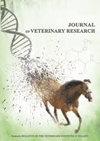Effect on the splenocyte function of weaned piglets induced by continuous lipopolysaccharide injections
IF 1.3
3区 农林科学
Q2 VETERINARY SCIENCES
引用次数: 0
Abstract
When piglets are exposed to pathogens for a long period, the immune system organs, among them the spleen, play a major role in combating the stress caused by those pathogens. In the present study, the effect on splenocyte function was investigated in a model of weaned piglets in which stress was induced by multiple low doses of lipopolysaccharide (LPS). Forty-eight 28-day-old piglets were divided into two groups: the LPS group and the control group. During the experimental period of thirteen days, the LPS group was intraperitoneally injected with LPS (100 μg/kg) once per day, and the control group was injected with the same volume of 0.9% sterile saline. On the 1st, 5th, 9th and 13th days, the piglets’ spleens were collected for isolating splenocytes. The proliferation ability of splenocytes was evaluated by the cell-counting-kit 8 method. Flow cytometry was used to detect cell cycle stage and apoptosis, and the nitric oxide level of cell supernatant was also tested. In the experimental group, the proliferation ability of splenocytes was enhanced, the proportion of cells in the G0/G1 phase was smaller, and cells were promoted to the S and G2/M phases. Meanwhile, apoptosis was suppressed and nitric oxide release upregulated. The results were significantly different between the LPS group and the control group on the 5th and 9th days. The difference between the results of one group and those of the other suggest that after the 5th LPS injection, multiple low doses of LPS activated splenocytes and restored the number of splenocytes, which maintained and possibly enhanced the regulation of the immune function of the spleen.连续注射脂多糖对断奶仔猪脾细胞功能的影响
当仔猪长期接触病原体时,免疫系统器官(其中包括脾脏)在对抗病原体引起的应激方面发挥着重要作用。本研究以断奶仔猪为模型,通过多次低剂量的脂多糖(LPS)诱导应激,研究了脾脏细胞功能的影响。 48 头 28 天大的仔猪被分为两组:LPS 组和对照组。在为期 13 天的实验期间,LPS 组每天腹腔注射一次 LPS(100 μg/kg),对照组注射相同剂量的 0.9% 无菌生理盐水。第 1 天、第 5 天、第 9 天和第 13 天,采集仔猪脾脏分离脾细胞。用细胞计数 kit 8 法评估脾细胞的增殖能力。使用流式细胞术检测细胞周期阶段和细胞凋亡,并检测细胞上清液中的一氧化氮水平。 实验组脾细胞增殖能力增强,G0/G1 期细胞比例减少,细胞进入 S 期和 G2/M 期。同时,细胞凋亡受到抑制,一氧化氮释放增加。在第 5 天和第 9 天,LPS 组与对照组的结果有明显差异。 一组结果与另一组结果的差异表明,在注射第 5 次 LPS 后,多次低剂量 LPS 激活了脾细胞并恢复了脾细胞的数量,从而维持并可能增强了对脾脏免疫功能的调节。
本文章由计算机程序翻译,如有差异,请以英文原文为准。
求助全文
约1分钟内获得全文
求助全文
来源期刊

Journal of Veterinary Research
Veterinary-General Veterinary
CiteScore
0.90
自引率
5.60%
发文量
58
审稿时长
18 weeks
期刊介绍:
Journal of Veterinary Research (formerly Bulletin of the Veterinary Institute in Pulawy) is a quarterly that publishes original papers, review articles and short communications on bacteriology, virology, parasitology, immunology, molecular biology, pathology, toxicology, pharmacology, and biochemistry. The main emphasis is, however, on infectious diseases of animals, food safety and public health, and clinical sciences.
 求助内容:
求助内容: 应助结果提醒方式:
应助结果提醒方式:


